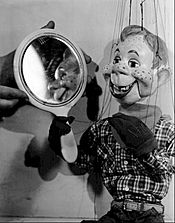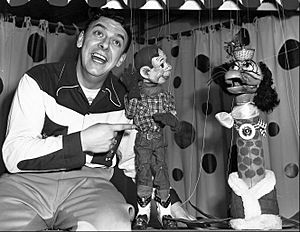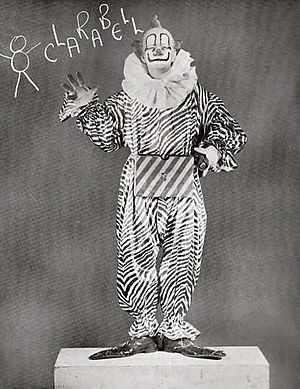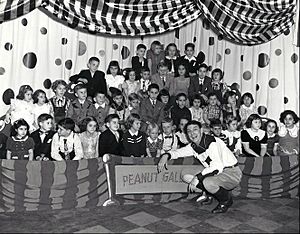Howdy Doody facts for kids
Quick facts for kids Howdy Doody |
|
|---|---|
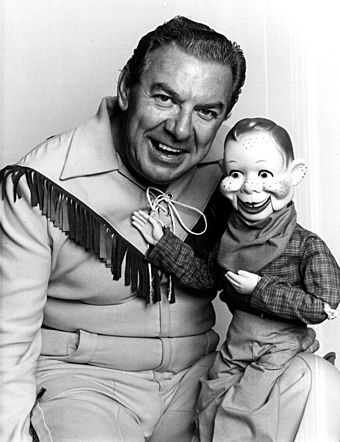
Buffalo Bob Smith and Howdy Doody in 1972
|
|
| Genre | Children's television series |
| Created by | E. Roger Muir |
| Presented by | Buffalo Bob Smith Howdy Doody |
| Starring | Bob Keeshan Lew Anderson Bobby Nicholson |
| Country of origin | United States |
| Production | |
| Producer(s) | E. Roger Muir and Nick Nicholson |
| Running time | 60 minutes (1947–1948, 1960) 30 Minutes (1948–1960) |
| Release | |
| Original network | NBC |
| Picture format | Black & White (1947–1955) Color (1955-1960) |
| Original release | December 27, 1947 – September 24, 1960 |
Howdy Doody was a popular American children's TV show. It had fun themes like the circus and the Wild West. The show was created by E. Roger Muir and aired on the NBC network in the United States. It ran from December 27, 1947, to September 24, 1960.
This show was a big step forward for children's television. It helped create the style for many other kids' shows that came after it. Howdy Doody was one of the first TV series made at NBC's Studio 3A in Rockefeller Center. It also helped introduce color TV. NBC, which owned the TV maker RCA, used the show to encourage people to buy color television sets in the 1950s.
Contents
Meet the Characters and Story
Buffalo Bob Smith first thought of Howdy Doody when he was a radio announcer on WNBC. Back then, Howdy Doody was just a voice that Smith performed on the radio. On December 27, 1947, Smith appeared on NBC's TV show Puppet Playhouse. People loved the Howdy Doody character so much that they wanted to see him on TV. Frank Paris, a puppeteer on the show, was asked to create a Howdy Doody puppet.
Bob Smith, the show's host, was soon called "Buffalo Bob." This name was a nod to the famous American frontier character Buffalo Bill and Smith's hometown of Buffalo, N.Y.. At first, the show's set looked like a circus tent. But it soon changed to a western town. Smith and the puppet both wore cowboy clothes. The puppet's name, "Howdy Doody," came from the old American saying "howdy doody" or "howdy do," which means "How do you do?" This phrase was also in the show's theme song. Smith, who started as a singing radio personality, often used music in the program. Cast members Lew Anderson and Robert "Nick" Nicholson were both skilled jazz musicians.
As the character and the TV show became more popular, people wanted Howdy Doody toys and items. By 1948, toy makers and stores were asking about Howdy Doody dolls. Macy's department store contacted Frank Paris, who made the puppet, about making dolls. However, while Paris created the puppet, Bob Smith owned the rights to the character. An argument started between them. Paris felt he wasn't getting enough money. After one fight, Paris took the puppet and left the NBC studios just hours before the live show. This had happened before, leaving the show without its main star.
When Paris disappeared before, quick excuses were made about where Howdy Doody was. This time, a detailed story was made up. They said Howdy was busy campaigning for elections. NBC quickly made a map of the United States. Viewers, with Smith's help, could see where Howdy was traveling. The story continued that while on the campaign trail, Howdy decided to get "plastic surgery" to look better. This allowed NBC to hire Disney animator Mel Shaw and his partner Bob Allen to design a new, more appealing puppet. Velma Wayne Dawson built and operated this new puppet. Bob Smith had called Paris's original puppet "the ugliest puppet imaginable." Since Paris didn't do the voice, Howdy's voice stayed the same after his look changed. This new puppet is the one most people remember as the "original" Howdy Doody.
Howdy Doody himself was a freckle-faced boy marionette. He had 48 freckles, one for each state in the U.S. at that time (before Alaska became the 49th state in 1959). Buffalo Bob Smith first voiced him. Different puppeteers like Dawson, Scott Brinker, and Rufus Rose created and built the show's marionettes over time. The redheaded Howdy puppet used 11 strings to move. Later, three more strings were added. The original puppet is now at the Detroit Institute of Arts. There were also duplicate Howdy Doody puppets for things like lighting practice or appearances. These duplicates were sometimes used on TV. "Double Doody," a Howdy stand-in puppet, is now at the Smithsonian National Museum of American History.
Photo Doody was a puppet with almost no strings. He was used for photos, parades, and the famous NBC test pattern. In 1997, he was sold for over $113,000 to a private art collector, TJ Fisher.
Who Are the Characters?
Puppet Friends
Besides Howdy Doody, here are some other puppet characters from the show:
- Heidi Doody: She was introduced as a stranger who saved Buffalo Bob's life in Africa. She became Howdy's sister.
- Phineas T. Bluster: He was a grumpy, stingy mayor of Doodyville and often Howdy's enemy. He was one of three Bluster triplets.
- Petey Bluster: Phineas's nephew.
- Don José Bluster: The Bluster brother from South America.
- Thaddeus Bluster: Another Bluster brother.
- Hector Hamhock Bluster: The British Bluster brother.
- Princess SummerFallWinterSpring: She started as a puppet, then was played by actress Judy Tyler. Tyler later starred with Elvis Presley in the 1957 movie Jailhouse Rock. After she died in a car accident in 1957, a marionette played the character again.
- Dilly Dally: Howdy's innocent childhood friend.
- Inspector John J. Fadoozle: Known as "America's No. 1 private eye." He was secretly "Mr. X" and ran against Howdy for "President of All the Boys and Girls of America." Kids could vote using ballots from Wonder Bread wrappers, a main sponsor of the show.
- Chief Thunderthud and Chief Featherman: Two Native American characters that fit the show's western theme.
- J. Cornelius Cobb: The shopkeeper, played by Nick Nicholson, who really disliked clowns.
- Sandra the Witch
- Capt. Windy Scuttlebut
- Flub-a-Dub: A mix of eight animals! He had a duck's bill, a cat's whiskers, spaniel's ears, a giraffe's neck, a dachshund's body, seal's flippers, a pig's tail, and an elephant's memory.
Animal Puppets
The show also had these animal puppets:
- Hyde and Zeke: Twin bears.
- Mambo: An African elephant.
- Tizzy: A dinosaur.
- Paddle: A gnu.
- Tommy Turtle: A slow-talking turtle who wasn't very smart.
Human Characters
There were also several human characters, including:
- The silent Clarabell the Clown. He talked using mime, honking horns on his belt, and squirting seltzer. Bob Keeshan, who later created Captain Kangaroo, first played him. Later, Robert "Nick" Nicholson and then Lew Anderson played Clarabell. Clarabell didn't speak because it would have cost more money, and the show had a small budget.
- J. Cornelius Cobb: Played by "Nick" Nicholson. He played this role at the same time as Clarabell, and then only Cobb when Lew Anderson became Clarabell.
- Sir Archibald (played by Dayton Allen): An explorer.
- Chief Thunderthud (played by Bill Le Cornec): The leader of the Ooragnak tribe (that's "kangaroo" spelled backward). Edward Kean created his famous greeting, "Kowabonga!" This nonsense word later became popular with California surfers.
- Princess Summerfall Winterspring (played by Judy Tyler): As a teenager, Tyler started her career in this role from 1950 to 1953. This led her to Broadway and Hollywood, where she co-starred with Elvis Presley in Jailhouse Rock. She sadly died in a car accident in 1957.
These characters lived in the made-up town of Doodyville. Comedian Dayton Allen, who later joined The Steve Allen Show, played several characters like Ugly Sam (the worst wrestler) and Pierre the Chef.
The Howdy show's rehearsals, which weren't on TV, were known for funny, grown-up jokes between the cast and puppets. Corny Cobb was played by Bobby "Nick" Nicholson in 1952. Puppeteer Rufus Rose played him in 1953 and 1954 while Nicholson played Clarabell. Nicholson returned to the role of Cobb from 1955 until the show ended.
Clarabell was first played by Bob Keeshan (who also played The Featherman). Keeshan stayed until December 1952. Then, he, Dayton Allen, puppeteer Rhoda Mann, and Bill LeCornec left the show because of a pay disagreement. Nicholson then took over as Clarabell for about 22 months. In January 1955, Anderson became Clarabell and kept the role for all later revivals. Nicholson then played J. Cornelius "Corny" Cobb. At the end of the very last episode on September 24, 1960, Clarabell finally spoke. He had been silent the whole series. He said the final words: "Goodbye, kids." A tear was seen in his eye as the screen faded to black. Some children in the audience could be heard crying.
Howdy Doody Dolls and Replicas
Howdy Doody dolls were sold in stores. You could also buy marionettes of Howdy Doody and Flub-a-dub. There were also marionettes of Don José and Hector Hamhock Bluster, who were Phineas T.'s brothers.
In the early 1990s, puppet maker Alan Semok created new, very accurate copies of Howdy. He used better materials and new ways to make them. He made a more exact marionette and a new Photo Doody. Bob Smith used this new Photo Doody for appearances until he passed away in 1998. One of Semok's duplicate marionettes appeared on a 2005 TV Guide cover. It showed Howdy with TV host Conan O'Brien dressed as Buffalo Bob Smith. Another duplicate is in the private museum of famous illusionist David Copperfield.
The Peanut Gallery Fun
A special part of the show was the Peanut Gallery. These were bleachers on stage where about 40 children sat. Each show began with Buffalo Bob asking, "Say kids, what time is it?" The kids would all shout, "It's Howdy Doody Time!" Then, they sang the show's theme song, which used the tune of "Ta-ra-ra Boom-de-ay":
- It's Howdy Doody time,
- It's Howdy Doody time,
- Bob Smith and Howdy, too,
- Say "Howdy do" to you.
- Let's give a rousing cheer
- ’Cause Howdy Doody's here.
- It's time to start the show
- So kids, let's go!
This made Howdy Doody one of the first TV shows where the audience played a big part. In many episodes from 1949–1954, kids also sang jingles for commercials. Buffalo Bob or Howdy would lead them, and the words appeared on screen. Products like Colgate toothpaste, Halo Shampoo, 3 Musketeers candy bars, and Poll Parrot Shoes were advertised this way. Wonder Bread was a main sponsor for the whole series.
The popularity of Howdy Doody and its Peanut Gallery led United Features Syndicate to name Charles M. Schulz's comic strip Li'l Folks as Peanuts. Schulz reportedly disliked this name his whole life.
Buffalo Bob's Absence
In September 1954, Bob Smith had a heart attack and needed to rest at home. NBC kept the show going with guest hosts like Gabby Hayes and New York radio DJ Ted Brown, who played Bison Bill. They told the kids that Smith was on vacation at Pioneer Village. Kids generally believed this, but show sponsors wanted Smith himself to sell their products. So, NBC set up a special studio at Smith's home. He could appear live "from Pioneer Village" to do commercials. While Smith was away, Allen Swift voiced Howdy. Swift continued to voice the character even after Smith returned in September 1955.
The Final Episode
The last episode, called "Clarabell's Big Surprise," aired on September 24, 1960. This hour-long episode mostly looked back at the show's best moments. During the show, Clarabell kept hinting at a "big surprise." The other cast members tried to guess what it was. Only Mayor Phineas T. Bluster found out and promised to keep it a secret.
Finally, at the very end, Clarabell showed his surprise to Buffalo Bob and Howdy Doody using pantomime. It turned out that Clarabell the silent clown could actually talk! Amazed, Bob told Clarabell to prove it, saying this was his last chance. A dramatic drum roll began as the camera zoomed in on Clarabell. His lips trembled. When the drumroll stopped, Clarabell softly said, "Goodbye, kids." A tear could be seen in his right eye as the screen faded to black. Some children in the Peanut Gallery could faintly be heard sobbing before the credits music played.
The show ended quietly with credits rolling over an empty, dark set. The song "Auld Lang Syne" played on a celeste. Then, an announcement said that The Shari Lewis Show would be on next week, followed by a commercial for the TV series National Velvet.
You can now buy the restored color video of the final broadcast.
Merchandise and Cartoons
A 1955 merchandise catalog had 24 pages showing all the different products licensed by the show. This included puppets, toys, clothes, and tie-ins with cereals and other foods. Dell published a comic book from 1950 to 1956. There were also Little Golden Books and Tell-a-Tale books, many written by the show's head writer, Edward Kean. John Stanley also wrote for the comic book. Kean also wrote some of a Sunday-only Howdy Doody comic strip with Stan Lee. It ran from 1950 to 1953 through United Feature Syndicate. Milt Neil and Chad Grothkopf were the first artists, then Grothkopf worked alone.
UPA made an animated cartoon called Howdy Doody and his Magic Hat. This was the first film directed by Gene Deitch. For a long time, people thought it was lost, but a copy was found at the Library of Congress in 2010. On April 15, 2010, the film was put online.
Howdy Doody Returns!
The 1970s brought back a lot of interest in the 1950s. Movies like American Graffiti and TV shows like Happy Days became popular. An episode of Happy Days in 1975 was called "The Howdy Doody Show." It had a storyline about Howdy Doody and featured Smith as Buffalo Bob. Actor Bob Brunner played Clarabell.
The New Howdy Doody Show
Soon after, Nicholson-Muir Productions (owned by Nick Nicholson and E. Roger Muir) bought the rights from NBC to make The New Howdy Doody Show. Buffalo Bob and most of the old cast tried to bring back their past fame. In this new version, which aired in syndication, the Howdy Doody puppet had real hair in a 1970s style. Puppeteer Pady Blackwood operated him.
The cast members included:
- Nicholson Muir (played by Bill LeCornec): The show's fancy, made-up producer. He was named after the production company.
- Corny Cobb (played by Nick Nicholson): He now worked as a "prop man" instead of a shopkeeper.
- Jackie Davis (Himself): The band leader.
- Happy Harmony (played by Marilyn Patch, then Dr. Marilyn Plavocos Arnone): A teacher in Doodyville who was similar to Princess SummerFallWinterSpring.
- Lew Anderson returned as Clarabell.
The show was filmed in Florida with a larger Peanut Gallery of children and their parents. This revived series wasn't as successful as the first one. It only lasted 130 episodes, from August 1976 to January 1977. Reruns of the show later aired on Sundays on Cozi TV. Recently, Amazon Prime started offering 20 episodes online.
It's Howdy Doody Time: A 40-Year Celebration
Ten years later, the show celebrated its 40th anniversary with a two-hour TV special. It was called It's Howdy Doody Time: A 40-Year Celebration. Smith, Anderson, Nicholson, and LeCornec (who played Chief Thunderthud again) were all in it.
Later in his life, Bob Smith became friends with Jack Roth, a fan from New York. Roth knew Smith's puppet characters very well. Since Smith's death in 1998, Roth has often voiced Howdy for TV appearances and live shows. Actor-puppeteer Alan Semok, who Smith asked to recreate the Howdy marionette, has also voiced Howdy.
Howdy Doody Around the World
Like Sesame Street later on, Howdy Doody had spin-off shows in Canada, Cuba, and Mexico. These shows used local actors and duplicate puppets.
La Hora de Jaudi Dudi (The Hour of Howdy Doody)
In March 1953, the Kagran Corporation, which made the original Howdy Doody for NBC, started making La Hora de Jaudi Dudi. This was a daily Spanish-language version filmed in Mexico City. It aired on Canal de las Estrellas in Mexico and, starting in April 1953, on CMQ-TV in Havana, Cuba. This version had a Howdy puppet without freckles and a new puppet named Don Burro. The goal was to make a show for all of Latin America. However, the company stopped production after six months because of unexpected problems and market issues. (At that time, Mexican TV was often improvised, and most South American countries didn't have TV or supermarkets.) They filmed 96 half-hour episodes.
Cuban television later launched its own local version called Chiriltin, which ran until late 1959 or early 1960.
The Canadian Howdy Doody Show
The Canadian Howdy Doody Show was made by the Canadian Broadcasting Corporation (CBC). It first aired on November 15, 1954. The CBC built its own Doodyville in a Toronto studio, and the show was set in Canada’s north. It had a smaller budget than the American version. The stories were less wild, the villains were less mean, and it focused more on education.
Most of the puppet characters were kept from the U.S. show. These included Phineas T. Bluster (the grumpy mayor), Dilly Dally (a foolish carpenter), Flub-a-dub (the animal mix), Heidi Doody (Howdy's sister), and Howdy himself.
But the Canadian show had some big differences. Other puppets included Percival, a parrot, and Mr. X, who traveled through time and space in his "whatsis box." The show had Howdy and Clarabell, but most of the human actors were different. For example, there was no Buffalo Bob. The show's host was Timber Tom, a forest ranger, played by Peter Mews.
Peter Mews later appeared in films and TV shows. One of his most famous roles was Matthew Cuthbert in the Charlottetown Festival’s Anne of Green Gables, which he played for over twenty years. Peter Mews passed away in 1984.
Clarabell was played by Alfie Scopp. Like the American Clarabell, he used mime, honking horns, and squirting seltzer to communicate. Scopp was born in London, England, in 1919 and moved to Canada. He had a long career in TV and film. He is known for playing the bookseller Avram in the 1971 film Fiddler on the Roof. He also voiced “Charlie-in-the-Box” in the 1964 Christmas special, Rudolph the Red-Nosed Reindeer.
Toby Tarnow played Princess Pan of the Forest, often called Pan. Tarnow was born in Gravelbourg, Saskatchewan, in 1937. She started acting at age eight and was performing professionally on CBC radio by age ten. In 1954, she was the first actress to play Anne in the live TV version of Anne of Green Gables. After Howdy Doody, she had a role on the CBC children’s show Mr. Dressup. Tarnow had a wide career in radio, TV, film, theater, and writing. She later founded a theater school in the United States.
Barbara Hamilton played Willow the Witch. She was a kind, absent-minded white witch. She was known for her work on Canadian stage and TV and was called "the funniest woman in Canada." Born in Kingston, Ontario, Hamilton studied at the University of Toronto. She became famous for her role in Arsenic and Old Lace. She played Marilla Cuthbert in Anne of Green Gables in Canada and London. She was also a regular on the CBC’s Road to Avonlea.
Larry Mann played the friendly pirate Cap'n Scuttlebutt. In Canada, the Cap’n was a live character, not a puppet like in the U.S. Mann also voiced Flub-a-dub on the show. Larry Mann was a character actor whose face you would always recognize. Born in Toronto in 1922, Mann was a radio DJ before acting. In his four decades of acting, he appeared in many TV shows like Get Smart and Gunsmoke. He also had big movie roles in In the Heat of the Night (1967) and The Sting (1973). Larry Mann passed away in 2014.
Another famous person who appeared on the Canadian Howdy was the singer and Broadway star Robert Goulet. He played the character Trapper Pierre.
The Canadian show had another Princess named Haida, who had the powers of a Medicine Man. Actress Caryl McBain played her. Other characters included Jean Cavall as Papa La Touke and Drew Thompson as Mendel Mason.
Some sources say James Doohan (Scotty from Star Trek) was the first host, playing Ranger Bill for a short time in November 1954. The story goes that he left to fight a forest fire, and Timber Tom (Peter Mews) took his place. However, Doohan never mentioned this role in his autobiography.
Another actress, Maxine Miller, started playing Princess Pan in 1954. She later played Nurse Farmer in the first three seasons of Misterrogers, the Canadian show that came before Mister Rogers’ Neighborhood in the U.S. She has appeared in over 120 movies and TV shows.
There is also some debate about whether William Shatner (Captain Kirk from Star Trek) appeared on the Canadian Howdy Doody Show. Some sources say he played Ranger Bob in 1954.
One character on the Canadian show was named Mr. X. This was not the same Mr. X as in the American Howdy Doody. The Canadian Mr. X taught history to the children watching. He would travel through space and time in his “Whatsis Box.” If this sounds familiar, it's because Sydney Newman, one of the Canadian show’s creators, later moved to England. There, he helped create the BBC program Doctor Who.
The actors who voiced the different puppet characters on the Canadian Howdy Doody Show included Claude Rae (Howdy Doody, Phineas T. Bluster, Mr. X), Jacqueline White (Howdy Doody), Norma MacMillan (Heidi Doody), Donna Miller (Prunella Bluster and Heidi Doody), and Jack Mather (Dilly Dally, Percival Parrot, and others). Larry Mann, who had experience with puppets, voiced Flub-a-dub. Hal and Renée Marquette were the puppeteers.
Besides the adventures in Doodyville and the Peanut Gallery, the show also featured films about nature or travel. Cliff Braggins adapted the scripts and wrote music for the show. Quentin Maclean provided organ music. Paddy Sampson produced the program. After almost five years, the CBC decided to cancel the show to create its own children's programming. The last Canadian Howdy Doody broadcast was on June 26, 1959.
Images for kids



